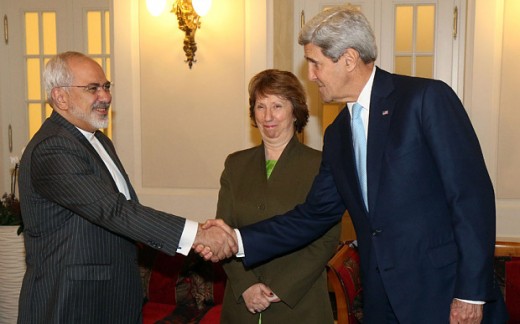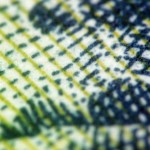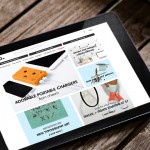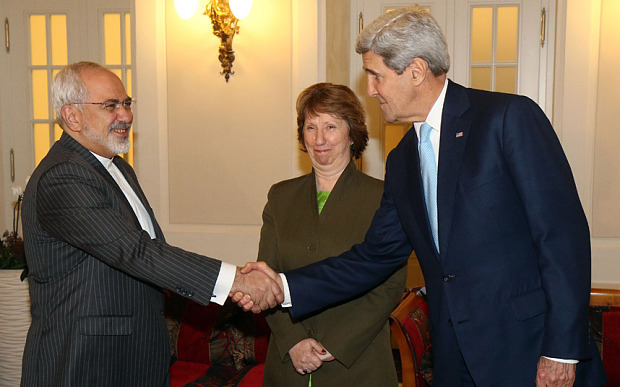Iran’s nuclear negotiations have devolved into a numbers game
Washington and Tehran are fixated on counting centrifuges when they should be thinking big, writes David Blair
Iranian Foreign Minister Mohammad Javad Zarif, left, shakes hands with US Secretary of State John Kerry as former EU Foreign Policy Chief Catherine Ashton looks on Photo: Ronald Zak/AFP/Getty Images
By David Blair, Vienna
November 22, 2014
When Vienna was an imperial capital, the Habsburgs would occasionally call their realm the “Danubian Monarchy”. In the interests of appeasing the subject peoples, it sometimes made sense to pretend the empire wasn’t an empire after all.
If only the diplomats who are now gathered here in Vienna to settle the confrontation over Iran’s nuclear programme could also avoid calling a spade a spade.
Skilled negotiators often seek to bridge the most unbridgeable divides by the time-honoured methods of fudging and renaming. The IRA never disarmed: instead it “decommissioned” its weapons and put them “beyond use”. The reason why these talks are deadlocked is that America and Iran have both allowed themselves to be impaled on one issue that remains defiantly beyond fudge.
The roadblock to a final agreement that could resolve the nuclear-tipped cold war between Washington and Tehran has remained the same for more than a decade. It comes down to one question: how many centrifuges will Iran be allowed to keep?
There is nothing particularly special about these machines, which were first used to enrich uranium in the Fifties. The particular examples which Iran is apparently prepared to pay any price to retain are based on a Seventies model. And Iran didn’t even design them itself: a reprobate called Abdul Qadeer Khan, who later helped to mastermind Pakistan’s nuclear weapons programme, pinched the blueprints from his European employers and then sold them to Tehran.
As I write, Iran’s foreign minister, Mohammad Javad Zarif, has just concluded a meeting with John Kerry, the US secretary of state, inside the whitewashed splendour of the Palais Coburg in Vienna. These two distinguished men, at the summit of their careers, were probably haggling over exactly how many of these antiquated machines, based on stolen designs, Iran should be allowed to keep. Their problem is that possession of centrifuges cannot be fudged. At present, Iran has 19,514 installed inside two enrichment plants. Under a final nuclear agreement, it will either keep them, or sacrifice them by the thousand. No euphemism will hide their fate. How has it come to this? Why might a pivotal agreement stay out of reach because of a few thousand centrifuges? The reason has everything to do with the domestic politics of Iran and America – and not much to do with the real subject of these negotiations, namely the future safety of the world and the avoidance of a nuclear arms race in the Middle East. Iran clings to its centrifuges for an official reason that, frankly, makes zero sense. We need these machines to make fuel for our nuclear power station at Bushehr and future civilian reactors – or so runs the Iranian argument. The problem is that Bushehr gets its fuel from Russia, and the design of the reactor is such that it cannot possibly work on fuel made by Iranian centrifuges. When one country builds a nuclear power station for another, the technical specification of the fuel needed to run the reactor is always retained by the seller. That is true of Bushehr – and it will remain true of the other civil reactors that Iran has ordered from Russia. As a result, it does not really matter whether Iran has one centrifuge or 100,000. Its scientists will not be able to use these machines to make fuel for its nuclear power stations. Even if Russia decided to break every precedent and pass on the secret codes for fuelling the reactors, this would still not help Iran. The only rationale for enriching uranium and making the fuel yourself is to achieve self-sufficiency. But Iran will have to import the uranium to run its power stations anyway. According to its own data, Iran’s domestic reserves of raw uranium are too small to sustain one nuclear power station, let alone the dozen or so that Tehran claims to be planning. Despite this, Iran has staked everything on retaining its centrifuges as an emblem of national pride. Sometimes, these obsolete machines are even paraded on state television. Meanwhile in Washington, President Obama must contend with a Republican Congress that is deeply sceptical about any talks with Iran. So he has assured the doubters that America will not sign any deal unless it keeps Iran about 12 months away from being able to make enough weapons-grade uranium for one nuclear bomb. In practice, that would mean Iran sacrificing almost 80 per cent of its centrifuges and accepting a limit of 4,000 machines. But if Iran ever actually made a dash for a nuclear weapon, it would not use the centrifuges inside its two declared enrichment plants, both of which are already monitored by the International Atomic Energy Agency. Instead, a secret facility would almost certainly be used. The crucial requirement for the West in any deal with Iran must therefore be transparency, including an absolute right for inspectors to go anywhere they choose. That matters far more than removing the machines that Iran would almost certainly never use to build a nuclear bomb anyway. Sadly, Iran and America have both ensnared themselves in the dismal business of counting centrifuges. If they allow an agreement to slip through their fingers for that reason alone, they should not be forgiven.
Telegraph Columnists: daily opinion, editorials and columns from our star writers
(184)















